#Alaskan Bush People
Text

Thinking Gabe and Raquel may have split?
Also a comment from Matt
2 notes
·
View notes
Text

Bam and his wonderful mom Ami ❤️
1 note
·
View note
Text
the Simpsons movie x the great north x alaskan bush people = me being 🤏🏻 this close to moving to Alaska
#the simpsons#the simpsons movie#2007#the great north#such an underrated show#and the intro song >#alaskan bush people#i feel like this show is probably problematic#but it’s 10/10 my guilty pleasure#i blame my mum#lololol#the other two are pretty wholesome though#anyway i don’t really like america#and i’d 1000% try and befriend a polar bear#but i do love the cold and whales are my favourite animals so#idk maybe i should move to alaska#(is alaska good for vegetarians…)#it has to be because Lisa survived there#and the simpsons is perfectly accurate#ALSO#whilst we’re talking about the simpsons in alaska#Maggie Simpson’s snow suit#i’d die for that outfit#10/10#incredible
1 note
·
View note
Text
Alaskan Bush People's Bear Brown sparks concern with 'horrifying' pic featuring BLOOD & axe as fans beg 'God help him'
Alaskan Bush People’s Bear Brown sparks concern with ‘horrifying’ pic featuring BLOOD & axe as fans beg ‘God help him’
ALASKAN Bush People star Bear Brown has sparked concern with a new photo, which featured blood and an ax.
Bear, 34, uploaded a scary Instagram photo that frightened his followers.
5
Alaskan Bush People star Bear Brown shared a production photo from his horror shortCredit: Instagram/bearbrownthekingofextreme
5
Bear titled his horror movie, Fear No EvilCredit:…

View On WordPress
0 notes
Text




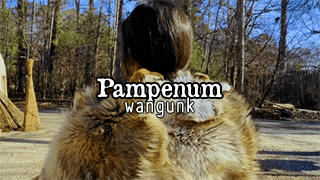



Historical Indigenous Women & Figures [6]:
Queen Nanny: the leader of the 18th century Maroon community in Jamaica, she led multiple battles in guerrilla war against the British, which included freeing slaves, and raiding plantations, and then later founding the community Nanny Town. There are multiple accounts of Queen Nanny's origins, one claiming that she was of the Akan people from Ghana and escaped slavery before starting rebellions, and others that she was a free person and moved to the Blue Mountains with a community of Taino. Regardless, Queen Nanny solidified her influence among the Indigenous People of Jamaica, and is featured on a Jamaican bank note.
Karimeh Abboud: Born in Bethlehem, Palestine, Karimeh Abboud became interested in photography in 1913 after recieving a camera for her 17th birthday from her Father. Her prestige in professional photography rapidly grew and became high demand, being described as one of the "first female photographers of the Arab World", and in 1924 she described herself as "the only National Photographer".
Georgia Harris: Born to a family of traditional Catawba potters, Harris took up pottery herself, and is credited with preserving traditional Catawba pottery methods due to refusing to use more tourist friendly forms in her work, despite the traditional method being much more labour intensive. Harris spent the rest of her life preserving and passing on the traditional ways of pottery, and was a recipient of a 1997 National Heritage Fellowship awarded by the National Endowment for the Arts, which is the highest honor in the folk and traditional arts in the United States.
Nozugum: known as a folk hero of the Uyghur people, Nozugum was a historical figure in 19th century Kashgar, who joined an uprising and killed her captor before running away. While she was eventually killed after escaping, her story remains a treasured one amongst the Uyghur.
Pampenum: a Sachem of the Wangunk people in what is now called Pennsylvania, Pampenum gained ownership of her mother's land, who had previously intended to sell it to settlers. Not sharing the same plans as her mother, Pampenum attempted to keep these lands in Native control by using the colonial court system to her advantage, including forbidding her descendants from selling the land, and naming the wife of the Mohegan sachem Mahomet I as her heir. Despite that these lands were later sold, Pampenum's efforts did not go unnoticed.
Christine Quintasket: also known as "Humishima", "Mourning Dove", Quintasket was a Sylix author who is credited as being one of the first female Native American authors to write a novel featuring a female protagonist. She used her Sylix name, Humishima, as a pen name, and was inspired to become an author after reading a racist portrayal of Native Americans, & wished to refute this derogatory portrayal. Later in life, she also became active in politics, and helped her tribe to gain money that was owed them.
Rita Pitka Blumenstein: an Alaskan Yup'ik woman who's healing career started at four years old, as she was trained in traditional healing by her grandmother, and then later she became the first certified traditional doctor in Alaska and worked for the Alaska Native Tribal Health Consortium. She later passed on her knowledge to her own daughters. February 17th is known as Rita Pitka Blumenstein day in Alaska, and in 2009 she was one of 50 women inducted into the inaugural class of the Alaska Women's Hall of Fame
Olivia Ward Bush-Banks: a mixed race woman of African American and Montaukett heritage, Banks was a well known author who was a regular contributor to the the first magazine that covered Black American culture, and wrote a column for a New York publication. She wrote of both Native American, and Black American topics and issues, and helped sculptor Richmond Barthé and writer Langston Hughes get their starts during the Harlem Renaissance. She is also credited with preserving Montaukett language and folklore due to her writing in her early career.
part [1], [2], [3], [4], [5] Transphobes & any other bigots need not reblog and are not welcome on my posts.
371 notes
·
View notes
Text
Making Better State Insects
So at some point I stumbled across a list of State Insects. Honestly I wasn't even aware states had "state insects", but as I looked down the list my disappointment grew. A vast majority of states had selected the European honeybee (which is not even native) as their state insect, with monarch butterflies and ladybugs being the two runner ups. I thought this was a damn shame because there's so many interesting insects in the US, so I'm making a better official new list of state insects.
For this list my criteria are:
Insect must be native to the state
No repeats
Insect must be easily observable to the naked eye
I also had general guidelines of picking insects that were relatively common (based on inaturalist heat maps of observation) and picking insects that were cool or interesting. Some of these insects I picked because I thought they were important parts of the areas culture and experience (lovebugs, toebiters, and periodical cicadas) and some insects I picked just to raise awareness that they exist in the US.
I also don't think I gave anyone huge L's, no mosquitoes, louses, cockroaches, ect, because my goal of this list is to get people interested in their native insects and I want it to be fun to find and observe your state insect.
Also some states get gold stars for picking state insects that already meet these criteria and are cool so they get to keep theirs. Some states also have "state butterflies" or "state agricultural insect" which for this list I'm ignoring, you can keep those I'm just focused on state insects. Slight disclaimer also, I've only ever lived in California, Nevada, Oregon, Washington, and South Carolina, and all these states are keeping their original state insect. So all the insects I'm choosing are for states I haven't lived in. Also I'm not including photos in this post just for my own sanity.
List under the cut!
Alabama
Old: Monarch Butterfly
New: Giant Leaf-footed Bug (Acanthocephala declivis)
Leaf-footed bugs are cute, they're big, they're stanced up, the males have big back legs, you've probably seen them. Being true bugs they have piercing mouthparts and suck plant juices.
Alaska
Four-spot Skimmer (Libellula quadrimaculata)
Alaska gets to keep their old state insect, it's a cool dragonfly and apparently was partially chosen to honor bush pilots who fly to deliver supplies in the Alaskan wilderness, so really cool!
Arizona
Two-tailed swallowtail butterfly (Papilio multicaudata)
Arizona also gets to keep their state insect. Kind of a shame because Arizona has a lot of cool species, but it did meet my requirements and they get points for choosing a different kind of butterfly.
Arkansas
Old: European honeybee
New: North American Wheel Bug (Arilus cristatus)
One of the largest assassin bugs in the US, these guys are appreciated by gardeners for their environmentally friendly pest control. They also look badass.
California
California Dogface Butterfly (Zerene eurydice)
Endemic to California and on a stamp! Again, kind of a shame because there's a lot of cool insects in California, but I respect this choice, especially since California was the first state to designate a state insect (1929).
Colorado
Colorado Hairstreak Butterfly (Hypaurotis crysalus)
Same deal as California, the state's name is in the common name, unique butterfly found in the four corners region. Just get a stamp or something soon!
Connecticut
Old: European Praying Mantis
New: Cecropia Moth (Hyalophora cecropia)
You picked a state insect no one else had but went with a nonnative mantis? Here's an insect that'll make you stand out and it's a native species. Lesser known than some of the other giant silk moths, the Cecropia moth is the largest native moth and has some truly stunning colors.
Delaware
Old: Convergent Ladybeetle
New: Periodical Cicada (Magicicada septendecim)
Cicada's had to be somewhere on this list and Delaware was one of the main hotspots for brood X, one of the largest broods of the multiple staggered brood cycles. Hey, they have a lot of history in America. Accounts go back as early as 1733, with Thomas Jefferson and Benjamin Franklin making a note of them.
District of Columbia
Old: None
New: Monarch Butterfly (Danaus plexippus)
The Entomological Society of America is trying to get the Monarch Butterfly added as our national insect, so I think that's reason enough to let DOC claim it.
Florida
Zebra Butterfly (Heliconius charithonia)
Florida gets to keep their state butterfly, but the populations that have existed in Florida are in steep decline. Ideally I would want being the official state insect to come with some protections, hopefully people can get invested in reintroducing them.
Georgia
Old: European Honeybee
New: Horned Passalus Beetle (Odontotaenius disjunctus)
Also called bess beetles or patent-leather beetles, these cute guys are important for forest systems because they eat decaying wood, helping to break down felled trees. They're cute beetles that squeak when disturbed.
Hawaii
Kamehameha Butterfly (Vanessa tameamea)
An endemic Hawaiian butterfly named after a ruling dynasty of Hawaii. Their population is under threat, as with a lot of native Hawaiian species, so I think this is a good state insect to build protections and activism around.
Idaho
Old: Monarch Butterfly
New: Ice Crawler (Grylloblatta sp. "Polaris Peak")
Look Idaho, I have to admit that even though I've traveled extensively through WA, OR, CA, and NV I've never stepped foot in Idaho and I don't intend to. Your state exists in a weird liminal zone, not really the pacific northwest but not really whatever Montana is either. Your state isn't even all in one time zone. So look, I really wanted ice crawlers to be on this list, but they're exclusively found on mountains in the pacific northwest and Sierra Nevadas. Normally I would've given them to Washington or Oregon, but those states already have state insects that work for them. So your state gets ice crawlers, and they do exist in Idaho in the panhandle. It's not an L, ice crawlers are amazing extremophiles that crawl over snow in high elevation mountain peaks. They exist in their own unique order and theres only one genus in the US, with different species being region locked, sometimes onto specific mountains. Their thermoregulation is so delicate, the warmth of someones hand holding them causes them to over heat and die. They're cool, unique, and weird, and let's face it so is your state. At least I didn't take a cop out by picking the potato bug.
Illinois
Old: Monarch Butterfly
New: Red-banded Leafhopper (Graphocephala coccinea)
Leafhopper done Chicago style.
Indiana
Old: Say's Firefly
New: Common True Katydid (Pterophylla camellifolia)
I wanted to give you Say's Firefly. I really did. But when I looked on Inaturalist not A SINGLE OBSERVATION was listed for the species in Indiana. I'm even going to post pictures.
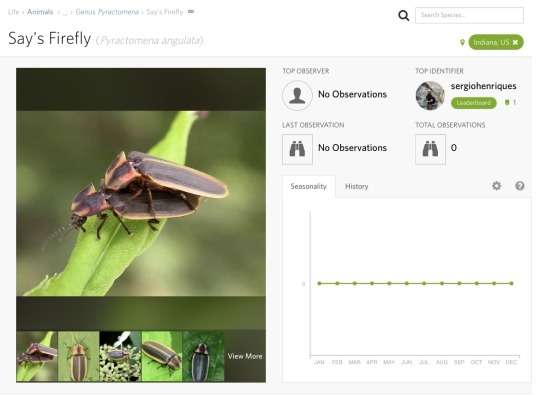
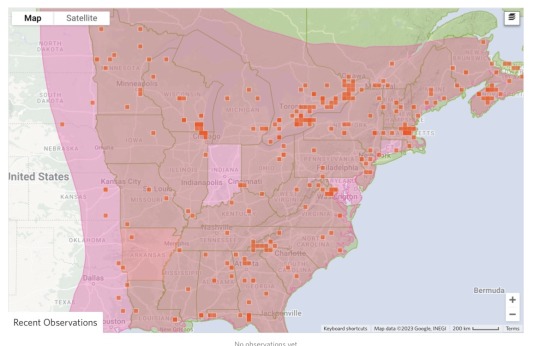
So even though this is extremely funny I'm giving your state the Common True Katydid instead. Large, loud, and easy to spot, these guys can frequently be heard chirping in trees. Not only do different populations have different rates of chirp, but the rate of chirp is also so predictably dependent on temperature that you could make an equation to tell the temperature based on chirp rate.
Iowa
Old: None
New: Westfall's Snaketail (Ophiogomphus westfalli)
Really cool clubtail dragonfly that's almost exclusively found in Iowa, Missouri, and Arkansas.
Kansas
Old: European Honeybee
New: Rainbow Scarab (Phanaeus vindex)
A kind of true dung beetle, they play an important role in removing waste. And although they don't roll waste like the stereotypical dung beetles, they are extremely pretty.
Kentucky
Viceroy Butterfly (Limenitis archippus)
This is fine.
Louisiana
Old: European Honeybee
New: Lovebug (Plecia nearartica)
Look, one of the southern states was going to get this one and Louisiana has a majority of the observations for them. Although annoying, it's things like having to scrape thousands of flies off your car that makes the Southern experience. Embrace it!
Maine
Old: European Honeybee
New: Brown Wasp Mantidfly (Climaciella brunnea)
I really wanted these guys to be somewhere on the list. Neither a wasp, mantis, or fly, these are predatory neuropterans related to lacewings. They have raptorial front legs (resembling a mantis) and their coloration resembles paper wasps that they live alongside. Weird, unique, and wonderful!
Maryland
Baltimore Checkerspot Butterfly (Euphydryas phaeton)
This butterfly might've been picked for the resemblance of the state flag. It's in decline in it's native range, so hopefully more awareness and consideration to state insects will help push conservation efforts.
Massachusetts
Old: Ladybug
New: Hornet Clearwing Moth (Paranthrene simulans)
Hornet mimic moth, the caterpillars feed on chestnuts and oaks. All lepidopterans (moths and butterflies) have modified hairs on their wings that form the "scales" that give this order their name. For this moth though, parts of it's wings don't have any scales so it more convincingly resembles a hornet. Underneath the scales, butterfly and moth wings look pretty much like any other insect's wing. Cool!
Michigan
Old: None
New: American Salmonfly (Pteronarcys dorsata)
The biggest salmonfly in North America. They make excellent fishing bait, and several fly fisherman use salmonfly lures to catch trout. Their nymphs are also an important indicator of water quality, with them being one of the first species to disappear in the presence of pollution or contaminants.
Minnesota
Old: Monarch Butterfly
New: American Giant Water Bug (Lethocerus americanus)
Also one of the ones that had to be on the list somewhere, and the Inat heatmap says Minnesota. Toebiters are part of the experience, and they are cool and ferocious looking.
Mississippi
Old: European Honeybee
New: Eastern Eyed Click Beetle (Alaus oculatus)
Click beetles have a cool adaption that allows them to launch themselves in the air to avoid predators. This makes an audible sound, hence their common name. The Eastern Eyed Click Beetle is one of the largest and most striking click beetles in the US, with large false eyespots on their thorax.
Missouri
Old: European Honeybee
New: Goldenrod Soldier Beetle (Chauliognathus pensylvanicus)
A soldier beetle that feeds on aphids and small plant pests, these beetles also eat pollen and nectar from flowers. They don't harm the flower, and though their common name reflects their preference for goldenrod flowers, they're also an important pollinator of the prairie onion (Allium stellatum). This is a native species of onion that grows from Minnesota to Arkansas.
Montana
Old: Mourning Cloak
New: Western Sheep Moth (Hemileuca eglanterina)
Mourning Cloak butterflies do technically work for my criteria, but I wanted to showcase some more regional insects in this as well, as Mourning Cloaks are found throughout North America and Eurasia. The Western Sheep Moth is an absolutely stunning giant silk moth, found throughout the western United States. Although not as big as some other silk moths, the bold orange and black coloration on these make them absolutely stand out.
Nebraska
Old: European Honeybee
New: Blowout Tiger Beetle (Cicindela lengi)
A tiger beetle with unique patterns, these guys are active predators and are particularly difficult to spot because they run extremely quickly. They seem to be pretty cold tolerant and exist from Colorado up into Canada.
Nevada
Vivid Dancer Damselfly (Argia Vivida)
This damselfly was picked as Nevada's state insect because it's widespread throughout the state and matches the state colors, silver and blue. That gets my seal of approval!
New Hampshire
Two-spotted Lady Beetle (Adalia bipunctata)
This is fine.
New Jersey
Old: European Honeybee
New: Margined Calligrapher (Toxomerus marginatus)
A pretty hoverfly, they strongly resemble bees in both looks and behavior. Larvae feed on common plant pests such as thrips and aphids, while the adults sip nectar and pollinate flowers. These helpful attributes make it something the Garden State can appreciate!
New Mexico
Tarantula Hawk (Pepsis grossa)
New Mexico wins the official state insect list by a landslide. Not only is the tarantula hawk a super cool and formidable insect to showcase, but New Mexico's state butterfly (Sandia Hairstreak) was discovered in New Mexico. No notes 10/10!
New York
Nine-spotted Lady Beetle (Coccinella novemnotata)
A native species of lady beetle that's been in decline in recent years, New York is one of the last remaining states where they've been spotted. I also appreciate that New York designated a specific ladybug species instead of just saying "Coccinellidae species".
North Carolina
Old: European Honeybee
New: Eastern Rhinoceros Beetle (Xyloryctes jamaicensis)
A large native species of rhinoceros beetle. They breed in ash trees, and are under threat due to competition from the Emerald Ash Borer.
North Dakota
Old: None
New: Nuttall's Blister Beetle (Lytta nuttalli)
As with all blister beetles, these guys have a chemical defense. Unlike the more famous Bombardier Beetle thought, instead of being black and red they are iridescent red/purple and green.
Ohio
Old: Ladybug
New: Bald-faced Hornet (Dolichovespula maculata)
Look, when the one thing everyone knows about your state is that it sucks, it's time to lean into it. Bald-faced hornets, everyone knows them, everyone has opinions about them, and they get a lot of attention. I don't think I have to explain this one anymore.
Oklahoma
Old: European Honeybee
New: Giant Walking Stick (Megaphasma denticrus)
The largest insect in the United States. Being a native walking stick, they're less damaging than the imported invasive walking sticks that are heavily controlled.
Oregon
Oregon Swallowtail Butterfly (Papilio oregonius)
Oregon in the common name and in the species name, and also has a stamp!
Pennsylvania
Pennsylvania Firefly (Photuris pensylvanica)
Pennsylvania in the common name and species name. If fireflies weren't already on this list I would've made sure to include them somewhere.
Rhode Island
American Burying Beetle (Nicrophorus americanus)
When I saw this on the list I was worried. American Burying Beetles are one of my favorite insects, but they're extremely endangered now. I also thought they existed more in the midwest, so I was worried I would have to change this one because it violated the "native to the region" rule. But! To my pleasant surprise, not only did their historic range extend to Rhode Island, but there is actually a carefully maintained wild population on Block Island. They estimate between 750-1000 individuals live there, making it one of the few remaining places where the American Burying Beetle still exists. Excellent work Rhode Island!
South Carolina
Carolina Mantis (Stagmomantis carolina)
This is fine. I wanted to give South Carolina the Palmetto bug but they're actually not native.
South Dakota
Old: European Honeybee
New: Golden Northern Bumble Bee (Bombus fervidus)
"Save the bees" should really be focused on native pollinators, many of whom are in decline. There are a lot of species of native bee you can feature as a state insect, with the Golden Northern Bumble Bee being a particularly large and striking species.
Tennessee
Old: Firefly and ladybug
New: Black-waved Flannel Moth (Megalopyge crispata)
Seriously look them up, these guys are adorable.
Texas
Old: Monarch Butterfly
New: Rainbow Grasshopper (Dactylotum bicolor)
It was really hard to pick an insect for your state. The Texas Unicorn Mantis was a contender but I eliminated it because it's really only found in the southern part of Texas, so it was between the Rainbow Grasshopper and the Eastern Velvet Ant (or Cow Killer). I went with the Rainbow Grasshopper because it's more wide spread and common, and occurs everywhere except the east part of Texas. But the Eastern Velvet Ant only occurs on the east part of Texas, maybe you should get an East and West Texas insect? I also thought more people have probably already heard of the Eastern Velvet Ant than the Rainbow Grasshopper, which is a shame because they're super interesting to look at.
Utah
Old: European Honeybee
New: Mormon Cricket (Anabrus simplex)
Mormon Crickets are not true crickets, and instead closer related to katydids. Their common name comes from an early account of Latter-day Saint settlers in Utah. In 1848, a swarm of Mormon Crickets decimated the settler's crops, so the legend goes that they prayed for relief from this plague of insects. Later that year, a swarm of gulls appeared and ate the crickets, thus saving the crops. This is recounted in the "miracle of the gulls" story. To recognize their contributions, the California Gull is commemorated as Utah's state bird. I thought it was fitting then that the Mormon Cricket be recognized as your state insect.
Vermont
Old: European Honeybee
New: Long-tailed Giant Ichneumon Wasp (Megarhyssa macrurus)
A pretty wasp with an extremely long ovipositor, these wasps are common in deciduous forests across the eastern United States. They can't sting, and instead use their long ovipositor to stab into tree bark and deposit eggs on the horntail larvae that burrow into the trees.
Virginia
Old: Eastern Tiger Swallowtail Butterfly
New: Giant Stag Beetle (Lucanus elaphus)
A large stag beetle native to the Eastern United States. Although not as well known as their similar looking fellow stag beetles from Japan, these guys are a lovely chocolate brown instead of solid black. Like most stag beetles, they breed in decaying wood.
Washington
Green Darner Dragonfly (Anax junius)
I imagine this was chosen because it matches the flag.
West Virginia
Old: European Honeybee
New: Appalachian Tiger Beetle (Cicindela ancocisconensis)
This tiger beetle likes hilly terrain. As with all tiger beetles, they can be hard to spot because they run across the ground in search of prey. They are fast! But this can make it more rewarding when you finally catch up to one.
Wisconsin
Old: European Honeybee
New: Phantom Crane Fly (Bittacomorpha clavipes)
Don't believe old wive's tales about crane flies drinking gallons of blood, they are nonbiting. Those striking black and white legs are hollow, and are held out when they fly, making an extremely distinct sight that's been likened to sparklers or snowflakes.
Wyoming
Sheridan's Hairstreak (Callophrys sheridanii)
This is fine.
#insect#insects#state insect#long post#list#text post#entomology#bugblr#invertebrates#invertiblr#inverts#invert
195 notes
·
View notes
Text
What tv shows/films the Fellowship would watch:
Gandalf: Ok so Gandalf loves his true crime, he's always listening to podcasts and watching true crime tiktok. He also loves the cosy old lady crime dramas such as Poirot or Marple. Gandalf also enjoys hospital dramas. Basically if there's drama he's here for it.
Frodo: Frodo loves his period dramas, Bridgerton, Downton abbey, Call the Midwife all that jazz. He loves the old fashioned scandals and dramas. Will cry if a character dies.
Sam: Now sam loves his cooking shows, espcially Masterchef or Bake off and will attempt the challenges if he's feeling really inspired. He also loves gardening shows, you know the really british one where they speak in soft whispers so they don't distrurb the bees.
Pippin: Pippin is an absolutely a sci-fi fan, Dr Who, Star Wars, Star Trek you name it he's watched it. and yes he will talk in great detail about it. He's also obsessed with Marvel and has already decided what member of the avengers each fellowship member is. (Gandalf is Nick Fury)
Merry: Fantasy and horror all the way. He's more into dark fantasy like Game of Thrones but will watch Merlin and other shows to give himself a break from the gritty shows. He will also watch horror until he scares himself but he wont admit that to anyone not even Pippin. Also partial to a good zombie show. Knows all of American Horror Story off by heart.
Boromir: Secret Disney fan but can't let anyone else know. Also enjoys a good comedy show, stand up comedy or the comedy shows with his silly humour. He also loves Action films like Top Gun, Die Hard and John Wicks, has watched all the Fast and Furious films.
Legolas: Loves nature documentaires and finds David Attenborough's voice so soothing. He also enjoys a good fashion/makeover show and has binge watch RuPaul's Drag Race too many times to count (him and Thranduil watch it together)
Gimli: Now Gimli loves his history shows, you know the types that your dad watched on a saturday. Deep dive into the pyramids, Time Team, fancy graphics and digging up bones. Mainly about ancient structures and buildings really. He loves the ancient egyptians and has so many facts about their culture and their buildings. He also loves a good historical drama, as long as it's accurate.
Aragorn: Survival shows, Bear Grylls, Ed Stafford etc. He loves watching their shows and getting tips for future quests. He also enjoys shows about people who live int he wild e.g Alaskan Bush People as it give him nostalgia of his Strider days.
#this was silly but couldnt get it out my head#the fellowship#the fellowship of the ring#lotr#gandalf#frodo#sam#pippin#merry#aragorn#gimli#boromir#legolas
67 notes
·
View notes
Text
No. 51 - Alaska Airlines

This is one of my most requested posts. Apparently, a very significant portion of my readers fly Alaska Airlines!
That tracks. Alaska Airlines is the fifth largest airline in the US. A sort of anti-Flair, they are supposedly the least complained-about full-service carrier in the US. They are also one of five remaining US legacy carriers, along with American Airlines, Delta Air Lines, Hawaiian Airlines, and United Airlines. They operate a massive network primarily on the US West Coast, with bits branching out into nearby slices of the Americas. As one might surmise from prior knowledge of the size and population of Alaska, they're actually mostly based in Seattle.
Now, when it comes to their livery, there's one thing that stands out. At least, it stood out to me, and I'm sure at least some of you have had this thought too.

That is a human person's face on the tailfin. But who does that face belong to, and why is it on the Alaska Airlines fleet? This is precisely the sort of trivia I think anyone who knows me would expect me to be able to just rattle off, but actually...I don't know, and neither, as far as I can tell, does anyone else. Isn't that weird?
(By the way, it is indeed Alaska Airlines. I have always found that somewhat unintuitive. It's just not how you're used to hearing things phrased, right? It's Possessive Noun Airlines, Air Noun. America Airlines would sound weird. Alaska Airlines sounds weird. I am never surprised when people mistakenly say Alaskan Airlines, but it's Alaska Airlines. Just so we're all on the same page.)
Alaska's a bit of a hard place to navigate. Big empty place, lots of ice, lots of mountains, islands, trees...not very much asphalt. That's even true now, but it used to be way truer, and even back then people did still live there. And there's a lot of things those people might maybe like to have, like medical care, or food, or just the hypothetical possibility of getting somewhere without having to get the snowshoes out. In that sense, Alaska is a really perfect place for aviation to flourish.
More or less as early as physically possible, when there were planes available that weren't requisitioned for the first World War or owned by the ultra-rich, people were flying in Alaska. In a lot of ways the basic landscape hasn't changed that much. With its surplus of difficult environments and paucity of actual tarmac Alaska's harsh wilderness is an environment only suited for "bush" flying, using smaller, more rugged airplanes specialized for the environment. Some of the most popular models of bush plane are very old, not that dissimilar to what you'd see in the 50s and 60s - apparently, they just don't make them the same anymore, and as long as you don't get your de Havilland Beaver crunched horribly into the side of a mountain there's just nothing that can replace it. Alaska is full of planes on floats, planes on skis, and taildraggers on tundra tires, most of them high-wing and piston-engined. Bush pilots are a unique sort, often doing work that's neither glamorous nor lucrative (nor safe, with Alaska having two to five times the accident rate of the lower 48) but undeniably necessary.
That's not as true of Alaska Airlines. They have a modern fleet, a good safety record except for that one time, and as a category III carrier they make over a billion dollars in revenue each fiscal year, meaning their finances aren't too strained (except for that one time). Unlike the local carriers that connect remote parts of Alaska to resources and to major cities, Alaska Airlines connects Alaska to the rest of the nearby world. (Though it also does short, multi-stop milk run flights.) It's a necessary part of the ecosystem, helping to keep Alaska's beautiful but hostile terrain from getting in the way of daily life. Before they became Alaska Airlines, though, they were far more similar to what you might expect of...Alaska airlines.

Image: Roy S. Dickson
In 1932, a man with the fantastic name 'Linious McGee' started his very own airline. You could just do that back then. In 1934 it was merged into Star Air Service, another tiny airline. Star Air Service had also been founded in 1932, born from the flight-school-starting dreams of a wealthy miner with the similarly wonderful name 'Wesley Earl Dunkle'. Apparently Star had its first ever aircraft, a Fleet B-5 biplane, brought to Alaska by steamship, which I just find fairly interesting. I guess this was before you could even ferry an airplane directly to Alaska by air. They ate up a few other small airlines (and their routes), and in 1943 they won a small scuffle against another pretender to formerly rebrand themselves as Alaska Airlines. So it's been 80 years of that now!
They've gone from flying Curtiss Robins, Ford Trimotors, and Lockheed Vegas to flying basically only 737s, save a few vestigial A320 family aircraft acquired when merging with Virgin America which they plan to phase out by the end of 2024. Their livery is also on E175 regional jets operated by Horizon Air and SkyWest. The airplanes flying for them number around 300. That's incredibly large even by the standards of major airlines (not even counting the SkyWest planes that have the livery).

The Alaska Airlines livery is not breaking any molds and I need to say that upfront. This is a very straightforward pattern I've taken to calling the Lufthansa Declined, or the Lufthansa Line SAS Variation. (Because the push and pull of trend cycles in brand identity is basically comparable to chess, right? Maybe? No? Not really?) I've recently codified the concept of the Lufthansa Line, the straight line continuing where the tailfin left off to carve through the fuselage. This is a very common and very disappointing fuselage trope. The Declined, or SAS Variation, is named for an airline I specifically contrasted with Lufthansa from my very first post on this blog, SAS.
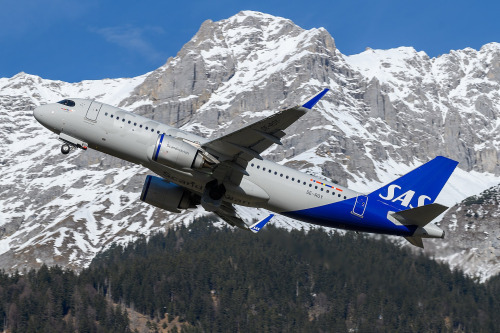
The SAS Variation simply curves this line outwards towards the front of the plane, stopping the cutoff from being quite so blunt and hopefully undoing the unbalancing effect somewhat. This can solve some of the nastier effects of Lufthansa Lines, particularly on shorter planes, but can also look very wonky if implemented without enough care. It's not always a big improvement, but it's definitely not the exact same thing, either, and it's this shape which Alaska Airlines attempts. Being introduced in 2016, this livery actually pre-dates SAS, but Delta and Lufthansa weren't starting their own namesake patterns either. The names aren't attributed based on innovation, but on formative status in my own specific understanding of airline liveries. SAS as contrasted to Lufthansa is the holotype for my creation of the taxon, and thus earlier liveries are retroactively SASlikes. Birds are dinosaurs and whales are ungulates. Taxonomy is imperfect and has to accommodate new discoveries within a sometimes unintuitive framework. That's just how it is.

I think they do better than many. The fact that they use so many colors, layered over each other, is crucial to the effect. It accomplishes similar things as a gradient might, transitioning from dark to light with minimal pain in the process.

Image taken from Alaska Airlines's very useful branding style guide.

The shades of blue and green used resemble the Aurora Borealis. I can't find anything confirming that this is intentional but I can't imagine it isn't. I think they're very nicely chosen. Different lightings can make the blue (Alaska's material calls it midnight blue, but it's technically Prussian blue) look anywhere from true vivid blue to more of a deep ocean color, which is one of my favorite shades. In particular, the very washed out yellowish green is an absolutely gorgeous choice for a highlight color. I like that the colors aren't given equal purchase, though, and that the green is used sparingly for highlight, and to create that lovely subtle 'halo' around the face on the tail. Sometimes less is more, and this is one of those cases. In fact, their own website states:
Midnight is our primary brand color, and should be used sparingly to avoid overuse—giving more prominence to the Alaska Airlines brand.
(They also note that they took specific efforts in the design process to make sure these colors had significant contrast between them to meet accessibility standards, which I really appreciate and want to see more of.)

For example, if the 'intermediate' blue colors took up more of the plane, or were separate from the green, I would probably not feel any real way about them. I definitely wouldn't think they were nice if they just did a standard Lufthansa Line block with each color individually expressed. But using them as a trim to a nice clear deep blue, overlapping each other in a way that's very carefully mapped out but seems at a glance essentially random, halfway to mixing, like the dark tail is melting slowly into the fuselage...that's nice. That adds something.

The partially-overlapping, brushlike curves are further expressed as swashes on the winglets and engines. What's interesting to me is that if you look closer you can see that the little curves are on both the inboard and outboard sides of each engine and winglet, so you get that consistent curve, hypothetically, no matter what angle you see it from. I do think I appreciate that. The curves are just never going to all line up, because airplanes are inconveniently three-dimensional and there are as many angles to view them from as there are Planck lengths at a distance where you can tell what it is you're seeing. This is a weakness in all liveries more detailed than a Braniff jellybean and adding the curves to even the side of the engine that you're usually not going to see is definitely an appreciated attempt to mitigate this. Does it work? Maybe not totally, but I see the effort.

While there's never a perfect syzygy into one continuous line, the curves seem like they're part of the same nebulous body from most angles. I appreciate this approach. I think making things look pretty good from most angles is worth more than making things look really good from one angle and awkward from all others. As they say, the perfect is the enemy of the good. I absolutely love the use on just the inside middle of the scimitar winglet, which I already think is a gorgeous feature that just elevates the MAX and retrofitted 737NGs compared to the vanilla model. It's distinctive and stylish, and the limiting of the color to just the lower half of the upper blade has a real restrained elegance to it - these slashes of color are all the more effective for the way they interact with the space around them.

Just look at these winglets. They're such a tiny feature. It's absolutely wild that I can be this in love with winglets, but there's just something about split scimitar wingtips that make me go completely wild. The amount of space and the interesting shape leaves so much more room for creativity than just about any other wingtip device. Alaska Airlines does have planes with other wingtip styles, and it uses those effectively too - covering the lower half of canted/blended winglets and fully encompassing the interior of less pronounced split winglets - but this is where they look their best.
Back to bad angles, though...


Alaska Airlines has a weird weak spot, and it's from the front and slightly above. All those gorgeous swoops on the winglets and nacelles are basically impossible to see due to their two-dimensional nature, and you can see how the colors don't fully cover the back of the fuselage. My normal policy is to judge liveries by their weakest link, but I honestly almost want to be lenient on this because of how unlikely it is that you're ever going to see an airplane from this angle. The only situations you're ever above an airplane in are ones you're basically never going to encounter as a regular passenger. Don't get me wrong, I still think this could have been designed in a way which eliminates this weak point, but as far as weak points go this is quite excusable. Is that what Thetis thought when she dipped her son in the Styx? Sure, probably, but I stand by my take. For a lot of liveries their worst angle is close to side-on, which is just fully experience-ruining. This? I'm okay with this, relatively speaking.

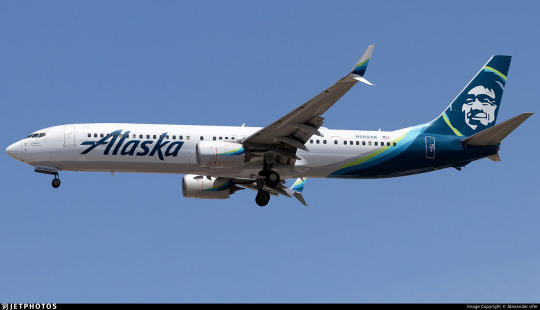
On the other hand, one of the better angles is one a lot more people will see - below and to one side. The taper of the different bands of color really prevents the awful jarring cutoff that Lufthansa Line and SAS Variation liveries often have, and I feel like they trick the eye into thinking up more of the fuselage is occupied than it really is. Also worth noting is that the grey underside, which resembles a shadow, is actually intentionally painted on, which is lovely. This is a feature common to the Deltalike livery trend that I outline at the start of my Southwest post, which I do think is one of the things that makes me honestly a bit sympathetic to Deltalikes when looking at them next to Lufthansalikes - at least there's an attempt to distribute visual detail evenly. Deltalikes were already a bit dated by 2016 (it was not the longest-lived trend, though it came at a time in my life perfectly positioned to make me think it was more prominent than it was) while SASlikes were on the rise, and this livery has aspects of each, but it feels less like a conflicted result of an intermediate period in dominant trends and more like something which intentionally pulled features from both where it thought they might work best. It's rare that I get this sense from a livery. That's the right way to use trends - as inspiration, not a template.

Alaska Airlines is definitely not a true Deltalike, and I would argue it's not a true SAS Variation either. (For the record, I would consider the 1998 SAS livery a Deltalike, funnily enough!) It incorporates features of both, which makes me feel uncomfortable classifying it definitively as either, though it's definitely more of a SASlike than not. For example, from the side it just is a SASlike, because the grey doesn't go high enough and isn't contrasting enough to be visible except from below. This is in contrast to actual Deltalikes, which have a thin but clearly visible line on the lower side where the underside's block of color bleeds out.
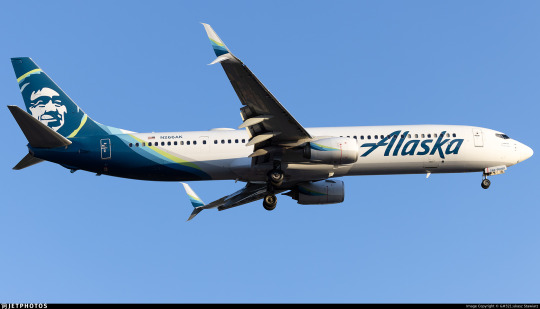

This grey color is also on the engine nacelles, although it is very subtle. This does bring up a minor gripe of mine, which is that the design on the pods cuts off at a bit of an awkwardly sharp angle, usually not worth remarking on but possible to notice from some angles if you are, say, a livery reviewer and you look at these things very closely. What I do like, though, is that the grey on the belly actively connects to the color on the tail, feeling like an extension of it instead of an awkward choice made to mitigate it.
The final specific feature of the livery I think I want to comment on is the wordmark. I really like the wordmark. It's not in their custom typeface, AS Circular, a Roboto-ish sans serif I'm not a gigantic fan of, although I really like their custom web icons. They also use Highest Praise by Adam Ladd, a fairly cheap commercially available font.

As for the wordmark itself, though, I can't seem to find what font it's based on! I have to say the original 1966 logo would be great if another airline were to use it, the 1972 is somehow giving supermarket chain, and the 1990 logo would be great if not for the weird way the K overlaps the A, which just feels sloppy and unprofessional. The 2014 and 2016 incarnations, though, are great. The 2016 one (designed by the firm Hornall Anderson) feels like a great update, just cleaning up the earlier version, though I somewhat miss the lightning-bolt S.


The placement is what I want to talk about, though. Placing a wordmark is more of an art than you might think - I'll show a couple examples of Alaska itself doing a slightly wonky job later - but when Alaska's placement is good it's great. It's one of the least cramped-looking wordmarks I've ever seen, feeling free and airy, spreading upwards above the window line. The descending line on the K and the trailing like on the A both create a feeling of freedom, like it could just keep going but doesn't want to, yet is tastefully restrained and doesn't actually overstep its bounds. I like the solid single color, and I like that it reaches almost to the engines, preventing that empty-forward-half feeling. The one thing I'll comment on for this set of images is that the left-to-right reading direction of English does mean that it looks distinctly worse seen from one side than the other. I much prefer the forward slant, which feels aerodynamic fitting with the motion of the plane, vs the alternative, in which it feels like the wordmark is trying to catch up with the aircraft's nose.
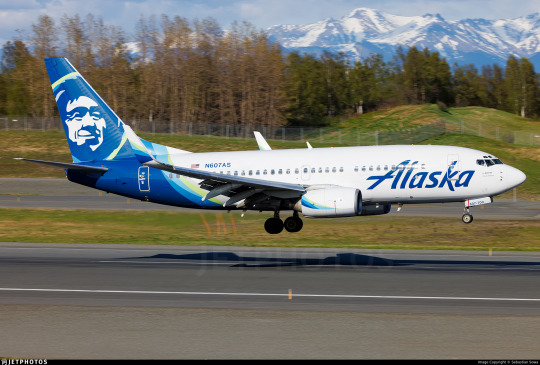
On shorter planes, though, Alaska fumbles a little. They choose to line up the wordmark with the engines instead of with the nose, creating an awkward look when it overlaps the door and nearly reaches the cockpit window. I would have leaned in the other direction were I them. This picture also demonstrates a strange feature which rears its head in certain lightings where the shading on the tailfin image makes it look almost wrinkled. I don't have anything to add to that or know how to solve it, but I need to point it out.
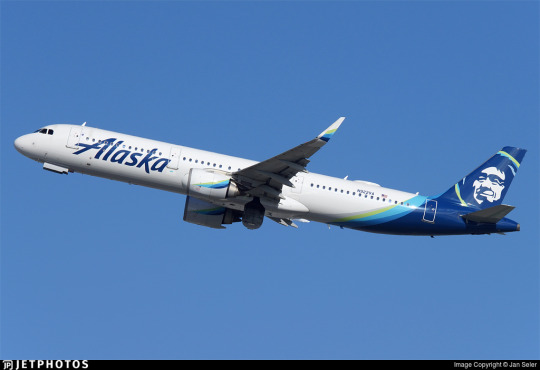
On a very long plane, conversely, the back half of Alaska's planes begins to feel that Lufthansa Line emptiness. The vast, vast majority of their planes are of a moderate enough length that neither issue is too overpowering, but I'm taking a wide view here! Also, the wordmark here seems to not be aligned with the engines, so...what's the idea?

Alaska Airlines is an interesting livery. More interesting than I thought I'd find it for sure. It's not just a SASlike with pleasing colors and a nice wordmark, it's a SASlike with thought put into features that can mitigate the inherent weaknesses of the SASlike. It doesn't always fully succeed, nor does it comprehensively fail, but it definitely tries.
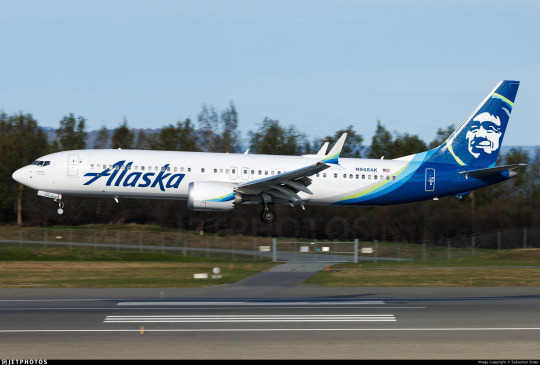
At the end of the day, as usual, I wish there was less white. I'm sure it could have been done. I don't have an obvious solution in mind like I do for some hypothetical redesigns, so it's something I would have to think over and really dig into, but, like, Alaska Airlines makes more than a billion in revenue every year so I think that's reasonable to expect from them.
I initially started using the grading system as a way to categorize liveries without limiting myself to a very specific scale that I'll dither about for years and then change my mind about later, but it's started to end up in that role. I just don't know what better solution there is, so I'm going to continue trying to make it work. Alaska Airlines is a livery that I ultimately think I like, that I think is designed decently, but that is limited by the fact that a really good SASlike is still a SASlike - mostly white and rear-heavy. It's getting the most possible out of a flawed paradigm, and I've been inconsistent so far on how I rate a good SASlike or Lufthansalike because it causes me some legitimate cognitive dissonance.
I'm giving Alaska Airlines a provisional B-.
I think I might downgrade it to C+ later, which is why I say it's provisional. A good execution of something really limited - how do I even rate that? It's somewhere between tepidly good and better-than-average, which is a really awkward place to be. But that's probably a conversation for another day, because this post is long enough and I'm still not done.
Okay, I teased this earlier.

Him. Who is he?

The short answer: nobody knows. Not me, and not Alaska Airlines.
The long answer: deserves its own post. Both because it's long, and because I've hit image limit. And there will be images. Join me in tomorrow's bonus, where we climb our way through the rugged terrain of seemingly-lost history to attempt to put a name to this ubiquitous face.

#tarmac fashion week#grade: b-#era: 2010s#era: 2020s#region: north america#region: united states#alaska airlines#legacy carriers#lufthansa declined#deltalike#skywriting
51 notes
·
View notes
Text
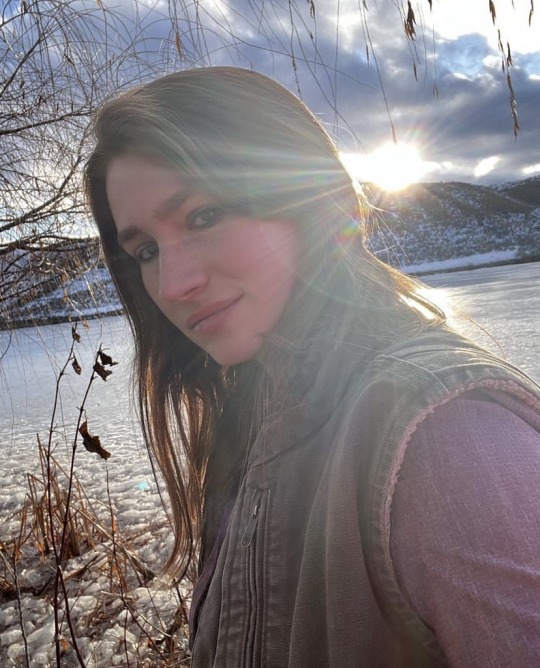
She’s so pretty I can’t even handle it
14 notes
·
View notes
Text
You know what makes me think that humans are way more connected to canines than we think? Whenever I watch a series about survival in the wild, people randomly start to howl. They don't scream, they don't roar, they just howl out into the distance. I find that so interesting that they all have the same urge. In Germany we have a series called 7vsWild where usually 7 people go alone into the wild for 7 days and need to survie (this time it's 14 people in 7 groups for 14 days) and no matter if it was season one, two or now in the third season, everyone howls at least once. Not just in this show tho of course, I noticed that in multiple other survival shows, where howling is a big thing. German shows, as well as in alaskan bush people for example.
23 notes
·
View notes
Note
Hello! Hope you are well. I wanted to ask if you would be able to give some insight into rural/small town medicine and dynamics? I want to be a social worker that potentially works in rural areas but I was wondering how things/the needs/the way things are different there that is compared to the suburbs or the city? Thank you for all your posts and have a good day!
If you haven't lived in a rural area, you need to do that before you consider moving there permanently. Different rural areas are WILDLY different, both in social makeup and in weather/geography/distance from urban areas. Some basic commonalities you'll encounter are that life takes place in a fishbowl; every single person you run into has a decent chance of being connected to someone else, so never talk shit until you know whether and how they're related to the person you're talking to. Never assume you can do something without it getting back to you but also your boss. Social services are generally based on property taxes and rural areas are poor, so funding will suck, there will not be enough professionals, the workload will be nuts, and your patients will be on Medicaid, which varies from state to state in terms of coverage. You'll also see a rotating cast of well-meaning people who moved out the sticks thinking it would be one way and leave as soon as they can because they discover they hate it. Older people are more likely to stick around in rural areas and placing older adults in memory care or skilled nursing or assisted living facilities (these are all different) is a bitch and a half because our country does not give one hot shit about vulnerable elder adults.
Find someone in the area you think you're interested in and shadow them before you consider moving there. I have no idea how many doctors, APCs, mental health professionals, social workers, pharmacists, physical therapists, occupational therapists, nurses, and nursing assistants I've seen get the hell out of Dodge after moving here, but it's the majority of posted positions around here. I'm notable because I've stuck around. I stuck around because I knew what this area was like and what to expect, because I was born and raised here, and my spouse was also born and raised here. (If you are partnered, there's a good chance your partner will hate it or they won't be able to find work. If you aren't, the dating pool is very shallow, especially for a professional who may not have as much in common with people working blue-collar jobs.)
Rural America looks a lot of different ways. There are predominantly white farming communities as the major stereotypes go, but there are fishing communities, there are communities in the South and the Southwest, there are predominantly Black communities, there are predominantly Native American communities, there are predominantly Latino communities, there are migrant farm laborer communities that shift drastically depending on season, there are Alaskan communities where you are hundreds of miles by bush plane from the nearest clinic let alone hospital. Rural Hawaii is going to look different and need different things than rural Ohio. Rural Mississippi is going to be very different than rural Maine. So look at where you're interested in going, reach out to local professionals, maximize any interpersonal connections. Who you know is everything. Your word is your bond. Never, ever, ever be rude to someone on the phone, never flip anyone off in traffic, basically be the opposite of any New York New York stereotypes you have, because everyone is always watching you.
Just for an example: My next-door neighbor is the mother-in-law of a local ICU nurse I worked with during residency, who I know because we carpooled in preschool because her brother was in my year. One block away, an MA from the clinic I worked at before I quit and came to my current clinic lives with his dog. Oh, there's another point worth mentioning. Rural areas will have very limited employers. I have three clinics I can work at in a 45-minute commute range. I left the one that was 10 minutes away and now work at one that's 30 minutes away. There is some funding for repaying student loans; that narrowed my choice down to 2 employers. If I piss off the wrong person at my current employer, I'll have to sell my house and move.
I lived in the city for ten years. I went to the ballet, I went to museums, I went to restaurants, I went to public parks. I don't miss it. I would infinitely rather be out here with my trees. My only regret is that my husband wanted to live closer to town so I don't have 20 acres between me and my nearest neighbor; I can see their houses from mine. If you want a city life, do not think you can have that out here. I haven't been to karaoke since I moved; not only is there no karaoke for two hours, but even if there were, the place would be full of my patients, and no one looks at you the same way once they realize their doctor exists outside of the clinic and has a personal life, much less that you have normal human flaws.
Oh, and there's almost no public transit. Property taxes, etc. Walkability is not a thing here. And when the wind shifts, everything smells like manure.
#the attending dr. kristophine#no one should take this post as an opportunity to start talking about what their life in their small town is like#I don't care#it will be different than mine. I know that and so does the person asking
28 notes
·
View notes
Text
EVERYONE GO WATCH NORTHERN EXPOSURE ITS AN EARLY 1990S SHOW AND ITS SO CHARMING AND GENUINELY FUNNY
it DOESNT TAKE ITSELF TOO SERIOUSLY ITS ABOUT AN ALASKAN TOWN WHO WORK TOGETHER AND CARE FOR EACHOTHER THROUGH THE YEARS EVEN THOUGH THEY HAVE DIFFERENCES BUT ITS TONE UNLIKE ANY IVE SEEN
tHE TOWN HAS A TLINGIT POPULATION THAT IS A PART OF THE SHOW AND ARE TREATED WITH RESPECT AND AS THEIR OWN CHARACTERS AND THEIR TRADITIONAL MEDICINE AND MEDICINE MEN ARE TAKEN SERIOUSLY BY THE BIG TIME NEW YORK DOCTOR WITHOUT ANY EXPLAINATION OR FIGHT
ONE OF THE BEST MAIN CHARACTERS IS A HALF-TLINGIT GUY WHO JUST HANGS OUT END IS FRIENDLY WITH EVERYONE AND HAS A FASCINATION WITH MOVIEMAKING AND POP CULTURE!!! AND THERES A SPIRIT CALLED ONE WHO WAITS (who i love!! hes not OooOoo! I am an all knowong appirition!!! hes just like hey man. oh times have changed alot, huh? well, Im here because I want to help you, here, lets ask the river and the wind. but im not sure well get an answer but we can try) AND HE IS TRYING TO HELP FIND THE GUYS FATHER (who abandoned him and he was found by the river) JUST THERE EVERY FEW EPISODES.
they THIS COUPLE WHO'RE LIKE 19 AND 60 BUT THEYRE GENUINELY GROUNDED AND GOOD AND ARENT ONE SIDED
THERES A MILLIONAIRE WHO LIVES THERE WHOSE KINDA A FRANK BURNS BUT THE SHOW USE HIM AS A TOTAL PUNCHING BAG ITS NICE
THE TWO MAIN LOVE INTEREST CHARACTERS ARE THE NY DOCTOR AND A BUSH PILOT WHO HAS A HISTORY OF EVERY BOYFRIEND DYING AND THEY HATE EACHOTHER AND ITS ENEMIES TO FRENEMIES TO ?? CAUSE IM ONLY IN SEASON 2 BUT THE WRITING IS SO FASCINATING
THEY HAVE THESE DREAM SEQUENCES??? ALOT AND ITS THEYRE SO PLAYFUL!! THE WRITERS ARE HAVING A GOOD TIME THE ENTIRE TIME
therES THIS DUDE WHO RUNS A MORNING RADIO SHOW WHO HAD A ROUGH LIFE IN A LONG LINE OF PEOPLE WHO LIVED WITH ADDICTION etc. IN A TRAILER PARK AND HES THE CHILLEST MOST WELL ROUNDED CHARACTER PHILOSOPHICALLY AND IS KIND TO PEOPLE BUT HES NOT A 2D PUSHOVER OR LIKE. A HERO TO SAVE THE DAY?
AAAaAaaAaAAAaaA I HAVE SO MUCH LOVE FOR THIS SHOW I REALLY WANT YOU TO SEE IT!!!
#northern exposure#I didnt do them all justice but i dont want to do an essay rn i just wanna be hype#polyramble#caps
9 notes
·
View notes
Text
Day 18: Frost
This one’s for the lore! I have a few different refs of the creatures in Winter’s Everlasting

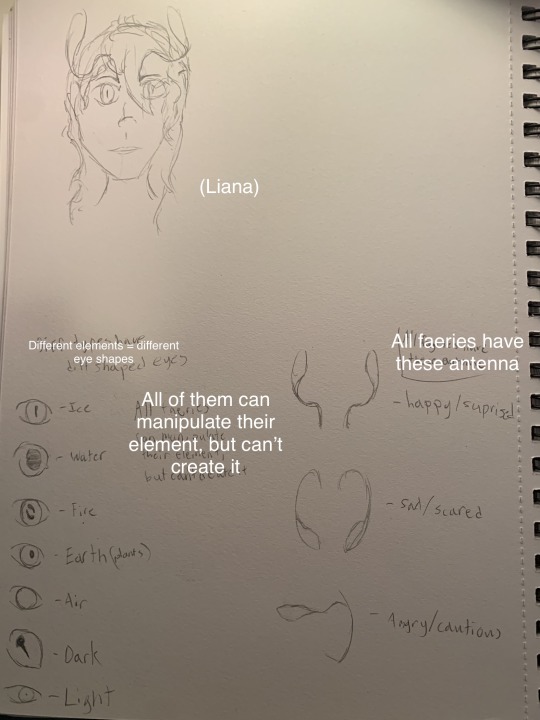

(in the final picture, top left is an Ice Person, top right is a Faerie, bottom left is a giant, and bottom right is a Frost Spirit)
If you want some more in depth info, look below
Creature index:
Human - I'm going to assume you're human yourself and know what that is
Greater Wolf - A large wolf about 8 feet long, as smart as a person and can stand and walk on rear limbs like one too. Their speech is similar to English with varying Northern European accents (depending on where the wolves live). They live underneath a king and his advisors, as well as regional representatives that come petition the king every year. Their king is very vain and often throws lavish parties; his advisors keep trying to reel in his excessive tendencies.
Faerie - Speaks in a language that everyone and no one can understand (except for those who speak it, who understand it just fine) which each creature can understand during certain hours of the day. There are 7 different types of faerie, all connected to different elements. While they can control virtually every aspect of their element, they can not create it. Have unprecedented magical capacity, thus actually making their lives harder by having to follow certain guidelines that come with all that raw energy. These include: Can't give their full name or they won't be able to deny whoever knows it. All favors they take or give must be repaid (if either party fails to repay before their death, they will become bad-type immortal until their deed is done). If they lie three times about the same thing, it will never be true. Can't kill something without their permission (excludes plants) Can't touch raw iron, it will cause pinpricks in the skin that feel like burning because their 'blood' is raw energy, being drawn like a magnet through their veins to the iron. Faeries have different colonies scattered throughout the realm, all of which have drastically different cultures. Mountains - The oldest living make the rules; they live in a small palace high in the peaks. Tundra - There are no rules, everyone for themselves; they live underground w/ entrances beneath bushes. Forested - Queen/King is determined through trial by combat; they live within large tree trunks. Plains - Communities of like-minded individuals who form deep bonds & claim territories; they live openly in flowering fields & sometimes with a hospitable/unaware giant.
'Dragon' (in circus) - A forbidden hybrid between a dragon and a greater wolf. At one point they were sentient, but over a lifetime of mistreatment (and being part dragon, they've lived quite a while) they've lost their mind to animalistic tendencies.
Ice People - Live in the Northern Kingdom in a giant glacier-plowed valley. Have a social hierarchy similar to arthurian times, with five classes: Royalty, Empowered, Median, Lesser, Lost. Each higher class can tell the lower classes what to do. They look like normal people carved of crystalline ice and stand at a statuesque height of 12 feet tall. They don't eat normal foods and instead survive off heat, which is converted internaly into energy. If they get too hot, it's like overeating to them. They will (depending on how hot it is) get fatter and if it's warm enough, rupture and die. (The warmest place in the land is like an Alaskan spring, so they can survive there, they'll just get fat.) Every house has a large fireplace of sorts where a kitchen normally is. Their queen is ferice, but surprisingly good at keeping her citizens happy.
Giant - Live in the warmest part of the world, though they can survive in much colder places. In legends, they are known to “breathe life” into the world; really their breath is so big and warm it melts snow and allows plants to flourish. Contrary to rumors, giants don’t eat much meat. Meat is easy for them to digest, therefore it’s highly unsustainable for their diet as they would have to eat many hundreds of pounds of it to satisfy them. Giants mainly eat large vegetation in spurts called ‘cravings��, where they eat many large plants in a single sitting. Afterwards, they don’t eat for an entire month. They try to spread out the devastation their cravings cause between multiple places to avoid upsetting the natural life.
Dragon - They come together to vote on a new leader every twenty years, though all the voted leaders have purposely been voted in due to their relaxed rules, so the laziest one is often the best candidate. For this reason, dragons are said to be lazy though many of them are far from it, and work hard to provide for themselves and others. They breathe ‘fire’, which is really a type of magic. Different species of dragons have different types of magic; the ones in Winter’s Everlasting have a negative version of fire, which is bitterly cold and sucks in light.
Frost Spirit - The magic energy left after a human perished in a cold environment. A lot of mystery surrounds them as most beings don’t even know what they were. Many of these spirits are stationary, though there are a few more restless ones who wander around the realm. They can speak with great difficulty, so they don’t do it often.
Magic:
-Comes in many fun colors depending on the wielder. soft yellow = faerie, electric blue = greater wolf, indigo = ice person, fiery orange = dragon
-Originates from faeries as they're born with a very high energy capacity. They 'created' magic by figuring out how to manipulate the energy into spells. All creatures have this energy, some just don't have much and are less likely to be good at magic.
-Iron has magic-absorbing properties. This is especially dangerous to the faeries because they have it running through their veins like blood.
-Tier list: Faerie (literally have raw energy as blood), Ice People (can directly convert heat into energy), Dragons (massive stores of energy are in its chest), Greater wolves (the same energy stores that a human would have), Giants (they are the anti-faerie due to the large amount of iron in their blood)
Naming: Greater wolves - things/actions, Ice People - verbs/descriptors, Dragons - sounds/actions, Giants & Faeries - strange names
#again I wish tumblr kept the unique text for each being but oh well#If y’all have any questions about the different creatures I’ll be happy to worldbuild!#g/t#giant tiny#promptober/inktober
7 notes
·
View notes
Text
"you're just judging me, not giving me advice!"
yeah dude, you want to go live "in the Alaskan wilderness" without interacting with society when your skills are on par with a mid-level girl scout from a temperature rainforest
my advice boils down to "don't" "no" and "you're going for Into Thin Air or a bush pilot rescue if you're VERY lucky--people who live up there live in SOCIETIES and always have, you wonderbread dipshit
#Anne has conversations#irl#buddy no#this is how you die from a myriad of things#including hypothermia (where are you getting wood on the tundra?)#malnutrition (“berry bushes fruit even in Alaska” not great if you don't know which ones)#and moose#i feel like moose should be its own 'can and will murk you' tag#he was..... sure a Human
2 notes
·
View notes
Note
hiiii tell me more abt alaska plz
Alaska is hecking huge. like... ENORMOUS. there's a mostly-in-jest rivalry with Texas, which is the next biggest state. like... this is a huge genre of T shirts, I'm not even kidding

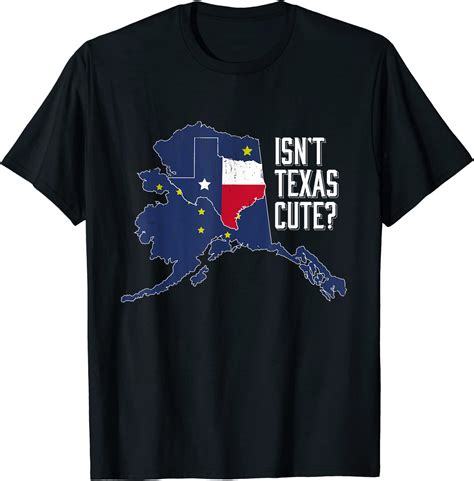
and because AK is so massive, it's extremely normal to go on VERY long drives. to the point that most Alaskans don't bat an eye at a one or two hour car trip, that's just like... the weekly trip to the grocery store.
and the road system is a hot mess. like, there's basically one way in, one way out of most places. for instance, if the Parks Highway gets closed for some reason (it's happened a few times due to wildfires alongside the road), a LOT of people who live in like... Houston or Talkeetna or any of the other tiny towns north of Wasilla/Palmer/Anchorage (Houston/Willow is where the Iditarod starts each year and TKA is the closest actual town to Denali, so they're easy to remember lol) won't have access to full-service grocery shopping or medical help unless they're airlifted out. which is like... a tad frightening to think about, but at the same time it has to do with the very small population density in AK. there aren't that many people per capita, so there just... aren't that many roads. a lot of people just straight-up own planes (like, bush planes) and fly around fairly frequently. I lived across a field from a small airstrip for awhile when I was a kid, it was great because the little planes would fly in low right over my house and if the pilots saw someone waving at them from the ground, they'd tilt the plane back and forth and wave back.
also this spot, here, Valdez:
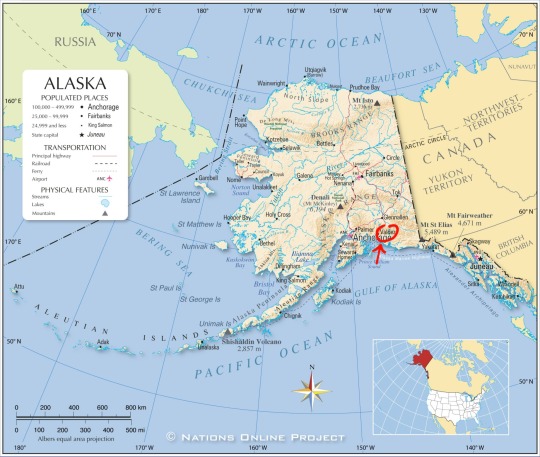
is #1, the end of the road system, #2, the end of the Alaska oil pipeline, #3, Prince William Sound (which Valdez sits on) was the site of the infamous Exxon-Valdez oil spill, and #4 — the original town was destroyed by a massive earthquake and subsequent tsunami in 1964 and the town had to rebuild a few miles up the road in order to not get washed out again. I'm mentioning this solely bc of my interest in seismological history, but also it's pretty cool to see EXACTLY where the literal End Of The Road is on a map tbh.
ok and one more fun tidbit: the World Ice Art Championship is held every year in Fairbanks AK

which is not only a huge tourist attraction (this is what I was talking about in my tags on that attractions post — North Pole is the actual name of a town that's basically a suburb of Fairbanks. they have like a Santa's Workshop type touristy thing that like, yeah it's kinda goofy but also they do have really good fudge skskdjsk) but ALSO a big deal for people who live IN ALASKA. people drive in from all over the state to walk through the park where they host the competition. they have like, ice slides and mazes and everything gets lit up at night, including the sculptures:


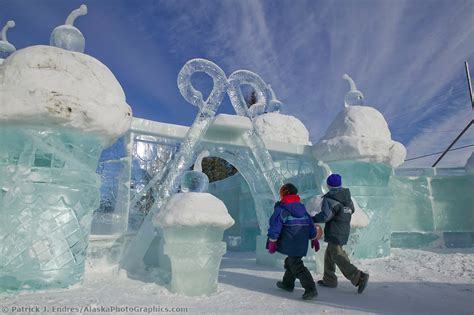
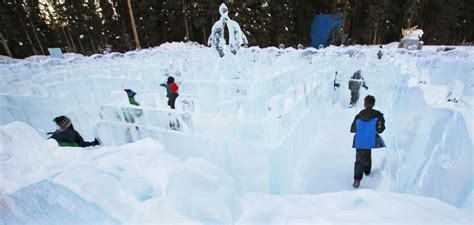
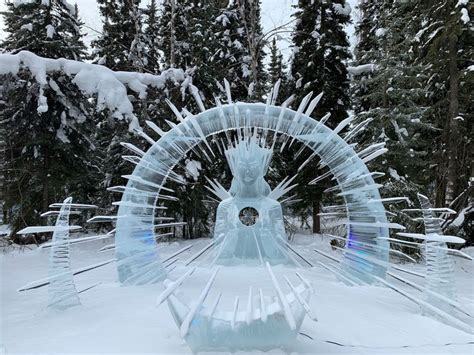

(top 4 pictures from, I believe, 2015 and 2017. bottom two, the same sculpture in daytime and then at night, was a presumably multiblock entry from 2021 that I couldn't find the name of who carved it/which team it was)
anyway part of my point here is: Anchorage/Wasilla/Palmer is a main population center in AK, people annually drive to Fairbanks for the Ice Festival, it's like a 5/6 hour drive. nobody is fazed by this. long distances to Alaskans are a minor inconvenience tbh.
#girl i have just spent like an hour rambling about my home state akdkfbsjfnakfh#anyway. alexa play alaska by sky sailing#Lu rambles#the ice art championship is SO FUN TO VISIT i love walking through and looking at all the sculptures. INSANE what humans#are capable of#i don't recall ever leaving alaska
27 notes
·
View notes
Note
16, 18, 20? For the Alaska asks?
Hello my friend!! Apologies for this being super late!
16 do you go berry picking? fishing? hunting?
I go berry picking! I love berries so much. There's so many raspberry bushes around the streets and such. You'll be walking down the sidewalk and you can pick raspberries as a snack while you walk.
I don't fish or hunt though. My bestie does, so she'll bring us fresh fish and pinks for Loki hehe hes a spoiled brat.
18 What are the unique aspects of Alaska's flora and fauna?
Ah, it’s so diverse and abundant. At the top of the land food chain, we have the brown bear Alaska contains about 70% of the total North American brown bears 🐻! People actually travel from around the world to see Alaska's Big 5: bear, moose, Dall Sheep, wolf and caribous, along with impressive marine mammals like humpback whales, orcas, and gray whales!
The ecosystems in Alaska range from grasslands, mountains, and tundra to thick forests. In the tundra, there are about 1,700 types of plants and they all tend to grow low to the ground.
Can't talk about Alaska's flora and fauna without mentioning our state flower and tree. The state tree is the Sitka spruce. It's a large, coniferous evergreen tree that grows to almost 100meters tall, with a trunk diameter that can exceed 5meters. Our state flower is the forget-me-not. It's a small clumpforming plant that grows 5 to 12 inches high in mountain meadows. They are quite fragrant in the evening and night time. There's little to no scent in the day time.
20 How do Alaskans’s deal with the extended periods of darkness in winter and continuous daylight in summer?
We are nicknamed The Land of the Midnight sun because we don’t experience true darkness over the summer, at least where I live. Below is a map of the sun during the summer. The term Civil Twilight essentially means that the sun sets but there’s still enough light to do normal daily activities.
During the summer, many people use black out curtains. They’re literally your best friends in getting any sleep. Adjusting to summer is by far easier than preparing for winter. Black out curtains and eye masks, thats it. Here's a small article on how to deal with the 24hr light.
Preparing for the dark, cold winters takes a lot more than preparing for winter. Alaska has some of the highest rates of depression so a lot of these recommendations and such are to avoid getting really affected by Season Affective Depressive (SAD). It’s rather unavoidable, but to minimize the effects Alaskans do the following: It’s recommended that we take Vitamin D, continue our daily activities and hobbies, continue being active by either walking or going to the gym. Its encouraged to get “Happy Light” to put in our offices and homes so it mimics daytime.
Utqiagvik, formerly known as Barrow, the furthest north city in Alaska, experiences 67 days of darkness, and over 80 days of interrupted daylight.

2 notes
·
View notes